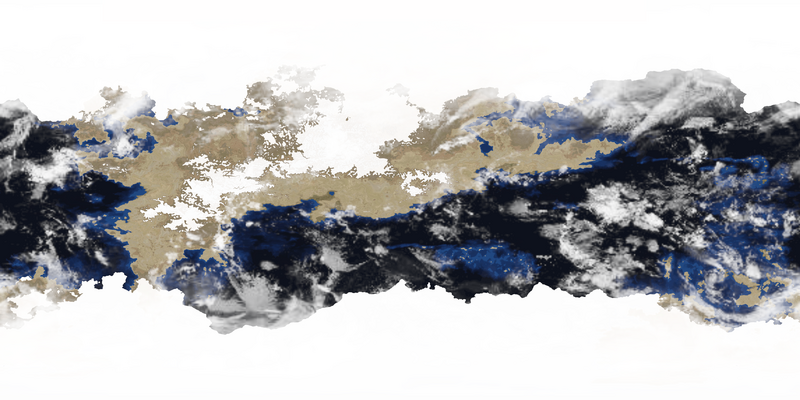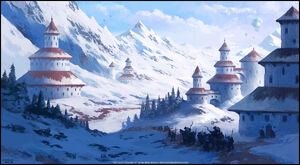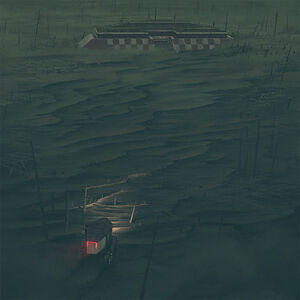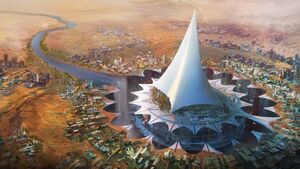The planet of Cabina is part of the Benilli system in Hex #0509. Though the Benilli system contains ten planets and dozens of moons, Cabina, third planet from the Benilli star, is the only planet in-system that carries political or strategic significance. The remaining planets in the system being lifeless rocks or gas giants with negligible population and natural resources. Cabina has no moon, only artificial satellites.
Though considered a backwater in mainstream imperial culture, Cabina was the homeworld of the Church of Humanity Repentant for 230 years, and is now the homeworld of the charitable organization SERAPH, which took over much of the CHR's activities on- and off-world following the latter's dissolution. It is the only planet in the sector with a human population that is overwhelmingly religiously non-conformist, with 80-90% of the population following the Repentant Faith instead of the imperial state religion of the High Church of Messiah-as-Emperox. This Repentant human population peacefully shares the planet with the much smaller population of the indigenous Cah-Binn aliens.
Following a complete ecosystem collapse after its bombardment during Second Imperial Civil War, the planet is in the midst of an on-going and extensive biosphere restoration project. Cabina's inhabitants largely embrace both the benefits and drawbacks of the planet's status as a 'backwater' colony outside of the core: they are detached from various kinds of Imperial scrutiny, resistant to certain kinds of record-keeping, and welcoming to immigrants and refugees looking for new start.
History[]
Prior to Human Settlement[]
- Main article: Aquilan-Cah Binn Conflict
Cabina is the homeworld of a species of intelligent aliens, known as the Cah-Binn. Before humanity's arrival in the sector, the Cah-Binn had settled a handful of systems surrounding Cabina, creating what ancient records call the Cah-Binn Interstellar Expanse. In the War for Human Prosperity, humanity destroyed the Cah-Binn expanse. Its territory was conquered, cities leveled, and population extinguished. Their immense alien fleet, guided by their great Gestalt Exoframes, had been hunted down, and what remained of Cah-Binn leadership following this genocide was left with no choice but to sign a treaty prohibiting space-faring and secluding them to their homeworld of Cabina.
The Cah-Binn spent the next 400 years as objects of curiosity and entertainment. As with many alien species during this time, those who were not driven to extinction were treated as playthings by humanity. Then in 2665, following the event known in human history as the Scream, humanity seemingly disappeared from Cabina, almost overnight.
After decades of silence from their captors, the Cah-Binn cautiously launched one of the few surviving Gestalt Exoframes into orbit. There, it was discovered that humanity had vanished from the system entirely, leaving nothing but ruins and corpses in their wake.
With humanity seemingly gone, and with them the imprisonment of the Cah-Binn, plans were quickly formed to take back what had been taken from them. The ground of Cabina shook as more and more alien spaceships came into being and began expanding into the system. The first colony was established on Prora, a world with a permanently frozen surface whose orbit is several hundred million kilometers further removed from the Benilli star than that of Cabina.
In 2763, explorers from House Vela rediscovered the Benilli system and found it crawling with Cah-Binn ships hunting for resources for their Exoframes. The Cah-Binn had remembered the Imperial tongue from their centuries in imprisonment and were able to contact the human ships, much to the horror and shock of the Velan teams. This dialogue appeared to avert immediate hostilities.
Humanity, still reeling from the effects of the Scream, was in no place to mount any unified response to the reemergence of the Cah-Binn. Enterprising, desperate, or foolhardy humans formed trade relationships with the Cah-Binn, buying from them items and resources that were still rare or unavailable in the post-scream economy. In return, the Cah-Binn learned how to outfit their ships with new spike drive propulsion systems.
Over the next century, this relationship continued to grow. The Cah-Binn established void-stations in the Tsatsos and Helesco systems, seeking new markets and new opportunities.
These new opportunities came with more attention, despite the initial contacts being one of cooperation and openness, humanities broader sentiments and prejudices had survived the Scream. The encroachment of an alien power in Imperial space was received with open hostility by some. However, the unstable nature of the sector at the time prevented any direct confrontation. That is until the crowning of a new Emperox.
Cabina and the Cah-Binn were one of the first targets for Empress Aquila Alejandra Ari’s reunification campaign. The timing of this campaign has been a subject of debate for some time. Many historians believe it was an attempt to unite humanity against a common foe, and to gain glory through emulating the first Emperox and humanity’s initial conquest of the aliens and the sector. Others believe it was an attempt to draw focus away from the unrest slowly building among some of the noble houses in the time after her coronation.
After a particularly brutal war of attrition and Pyrrhic victory on Prora, the Empress scrapped plans for a ground assault of Cabina, replacing it with something far more brutal and intending to make Cabina a message. In 2906 the Imperial fleet began the process of systematic planetary bombardment of every location that had the slightest potential of containing alien life. The nine months of bombardment wiped all visible Cah-Binn life from the surface, and as an unintended side-effect, Cabina’s ecosystem, which had always been fragile as a result of the cold climate, was sent into a tailspin which would end with its complete and utter collapse. Toxins left behind as a byproduct of the bombardement pollute much of Cabinan soil and waters to this day, hindering attempts at biosphere restoration.
Following the bombardment, a token garrison was deployed to the surface, tasked with little more than watching over the ruins of a dead world.
Human Settlement and Founding of the Church of Humanity, Repentant[]
Many years later in 2943, the garrison would be recalled to assist in the ever escalating Second Imperial Civil War. A small colony of settlers had sprung up around the garrison fort, and after the garrison's departure they claimed it for their own uses. They named the city, which would become the planetary capital, Lux Gravare, or “Burden of Light,” and committed to the work of restoring the planet.
It was only when they were gone that the few surviving Cah-Binn began to rise up from deep underground bunkers. First contact between the new human settlers and surviving Cah-Binn happened soon after, near what is now the city of Gadalfo, as the settlers went looking for places to procure resources for the rapidly growing capital of Lux Gravare.
Though understandably wary at first, the Cah-Binn begrudgingly accepted the humans' presence, and helped some of the first settlers survive the planet's cold and devastated climate. Though the devastation visited upon them by humanity was, and still remains, fresh in the Cah-Binn's cultural memory, over time many have come to like and trust their human neighbors. Helping build this trust was that part of the settlers offer of reconciliation was a promise: if anyone ever seeks to bombard the Cah-Binn again, they'll have to bombard millions of human shields along with them.
In 2969, the Church of Humanity Repentant was founded on Cabina, which would become the Church's headquarters and homeworld for the rest of its existence.
The following centuries saw the human population grow to vastly outnumber that of the Cah-Binn, and the different styles of habitation of two species means they largely live in separate communities. The main exception is Gadalfo, where Cah-Binn and human populations have intermixed to a larger degree than anywhere else on the planet.
Founding of SERAPH[]
- Main article: SERAPH Founding Timeline


Examples of recent developments on Cabina.
The collapse of the Church of Humanity, Repentant in 3200 left a gaping power vacuum on Cabina. Multiple entities competed for social and political prominence during this time, seeking to acquire the skills of individuals formerly employed by the CHR bureaucracy, the support of the noble families of Cabina, the support of now-independent Repentant sects, and control of the assets and land formerly owned or overseen by the CHR. Among the most prominent entities in this struggle were the Office of the Governor of Cabina, Cabina Cups Tea Company, Cabina Coffee Company, the Gran Panacea Charitable Foundation, the Maajid Memorial Foundation for the Education of Humanity, and AIDSERFS.
Out of the eventual compromises and agreements signed among these competing entities arose SERAPH, which is now the major power broker and conglomerate on the planet.
Planetary Characteristics[]
Geography[]
The planet's geography is roughly split between a single large continent, called Toterra, that dominates one hemisphere, and an ocean, called Maromnis, filled with archipelago's that dominates the other. Many areas of Cabina's surface are still scarred with craters, marking the (geologically) recent imperial orbital bombardments.
Continental Cabina[]
On the main continent of Toterra, the majority of the landscape is wasteland. It is thousands and thousands of miles of barren, dusty soil and skeletal trees. Occasionally the odd impact crater breaks up the monotony of the dead and lifeless expanse.
Cabinan soil is marked by dioxin pollution, resulting from the imperial bombardment several centuries ago. This is harmful to humans, but one generally has to be actively trying to ingest or breath in enough of the stuff for truly toxic effects. Its primary effect is that of rendering the soil barren and infertile. Rain falls, but rather than revitalizing the soil the equally polluted rainwater just ensures the soil remains polluted without immense and constant efforts that are only feasible near populated areas.
Oceanic Cabina[]
Like the soil, the massive amounts of dioxins produced by the imperial bombardment polluted the main ocean of Maromnis, and rendered it lifeless. Unlike the soil, the more piecemeal approach to restoration being done on land was from the outset impossible to apply to the ocean. Due to the currents connecting all parts of the ocean to each other, it needed to be treated as a single biosphere, and as much as possible restored as a single whole.
However, so far the oceanic biosphere restoration has been a mixed success. While dioxin levels have been lowered sufficiently for more advanced life to exist, the majority of the Cabina oceans are currently only barely more alive than they were before. Instead of completely lifeless, they are plagued with infestations of toxic black plankton and dotted with vast fields of poisonous Tiger Mussels that crowd out any other life.
The only truly vibrant areas are small areas of coral reefs planted and maintained by island and shore communities. With sufficient care, the coral forests can be kept clear of Tiger Mussels and black water, and particularly successful projects have been able to advance to introducing various species of fish and mollusk and begin to build some semblance of a proper aquatic ecosystem.
Climate[]
Cabina is a cold-to-temperate world with a breathable-mix atmosphere. On a geological scale, its planetary climate is notoriously fickle. Cycles of tens or hundreds of thousands of years of stability were regularly ended by sudden shifts in global temperatures, rising or falling by several degrees in the span of mere decades. In living memory, however, the climate has been stable to where large polar ice caps cover up to two thirds of the planet, and a warmer, temperate, climate band surrounds the equator.
Temperatures in arid areas on Cabina are still fairly pleasant compared to those on other planets. Cabina's deserts are rarely warmer than 20°C/70°F. The arid regions are as much the result of the ecosystem devastation as of meteorological conditions.
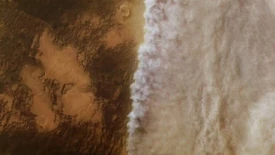
A dust storm captured by satellite.
Though there is rain and wind, on continental Cabina the most common weather phenomenon is dust storms. The lack of plant life rooting in the soil means that across the wasteland the surface is nothing but loose sand. As wind blows across mile after mile of sand, a gust of dust grows into massive storms, at times more than a mile high. Though the dust storms are present year-round, they're particularly common and large during dry seasons. Local Cabina News stations will regularly report on the possibility of dust storms and warn the populace about mega-storms that seem likely to hit frontier communities or major cities.
Biosphere Destruction and Restoration[]
See also PRISM NETWORK NEWS - SAVING CABINA by Aristotle Seide
See also BREAKING NEWS: Cah-Binn Cleaning Cabina Climate? by John Davelkolhn
Cabina's biosphere had always been fragile, as a result of the relentless cycles of millennia of stability ending in sudden global temperature shifts lasting mere decades. Though the most common species had found some way to adapt, Cabinan evolutionary history is littered with minor extinction events resulting from these sudden climatological turns, and its flora and fauna was never able to find the level of equilibrium found on more stable planets. However, it was not a climate shift, but rather the orbital bombardment from Imperial fleets during the Second Imperial Civil War that drove the whole ecosystem over the edge and into total collapse.
Over the past two centuries, the Church of Humanity Repentant and the Cah-Binn made significant efforts, independently and jointly, to restore plant and animal life to the planet. Efforts which are now being continued by SERAPH. As a result, most settlements are surrounded by swathes of flourishing flora and fauna. Outside of those, however, the planet remains dominated by barren and lifeless desolation, the soil itself rendered permanently infertile by the dioxin pollution.
Biosphere Pollution[]
The main cause of the ecosystem collapse, and the main hindrance to its restoration, is dioxin poisoning. These chemicals are complex, long lived organic molecules that are toxic to all forms of life. Trillions of tons of dioxins were created as a result of the imperial bombardment of Cabina. Now the dioxins can be found everywhere. In the rivers, in the oceans, in the rain, and perhaps worst of all, the dioxins can be found in extremely high concentrations in the soil.
Continental Biosphere Restoration[]
As a result of the extreme levels of dioxin pollution, even plants genetically engineered to be tolerant to dioxins can’t grow on Cabina. The soil first needs to be treated with special bacteria that can break the toxin down into harmless byproducts. It takes a tremendous amount of work to re-mediate even a single square kilometer of ground so that plants can be grown on Cabina again.
To make matters worse the cleaning never stops. Dust storms, driven by the cold winds coming off the massive glaciers ringing the northern and southern hemispheres of the planet, kick the dioxin laced soil back up into the atmosphere where water condenses around it before raining back down on the surface below. Every time it rains, the poisons return to the soil. Which means every time it rains the soils need to be treated again, slowing how quickly the planet can be reclaimed.
Oceanic Biosphere Restoration[]
Not just the soil, but the oceans too were polluted by massive quantities of dioxins, and left lifeless by the total ecosystem collapse. However, the even post-collapse the ocean is still a single great system, connected by water currents. Oceanic biosphere restoration could not follow the inch-by-inch model of surface soil reclamation, it had to go big or go home. First, massive numbers of aquatic dioxin-consuming bacteria were cultivated and released into the oceans. Then, a range of dioxin-resistant plankton, known as black plankton for its unusually dark color, that feeds on the dioxin-consuming bacteria. Then, a range of aquatic fauna, from fish to mollusks, that feeds on the plankton. The intention was to continue building the ecosystem after this initial seeding, but due to setbacks and unexpected side-effects of the first two steps, this has yet to begin. Instead, the majority of the Cabina oceans are currently only barely more alive than they were before. Instead of completely lifeless, they are now plagued with infestations of toxic black plankton and dotted with vast fields of poisonous Tiger Mussels that crowd out any other life.
After several failed attempts to fix this situation wholesale, efforts have switched to a slower approach. Currently, biosphere restoration is focused on regrowing green coral reefs around the settled islands and coasts. These coral reefs are engineered and planted so as to prevent mussel growth, and provide relatively safe environments in which more complex aquatic ecosystems, most prominently fish, are able to be seeded and survive. However, these reefs are still in danger from the black plankton algal blooms, colloquially known as 'black water', that regularly destroy whole swathes of restored coral. Oceanic frontier communities must continually check and maintain their coral forest to ensure it survives and thrives.
Biosphere Restoration Setbacks and Disasters[]
Attempts to hasten restoration through experimental techniques have had a tendency to, in spite of best intentions, back-fire on the project and Cabina population. Most infamously, the unintentional creation of the Shatter Zaffre lichen and the unexpected, and deadly, threat posed by the Bumbumast ur-swarms.
As an unforeseen consequence of re-introducing the Bumbumast to the restoration projects, the wasteland areas up to about a week's travel from such settlements are plagued by deadly ur-swarms of madly ravenous Bumbumast, posing a mortal hazard to anyone caught unawares and without proper protection. These ur-swarms are particularly common around the smaller settlements or homesteads, where people cannot afford the more advanced surveillance and control systems used by major settlements and cities to keep the Bumbumast problem mostly under control.
As another unexpected side-effect of restoration projects, settlements on Cabina are regularly threatened by outbreaks of the Shatter Zaffre lichen. The original Zaffre strain was introduced to Cabina to aid in soil decontamination, but quickly evolved into the Shatter variety, which rather than decontaminating the soil went and fed on commonly used construction materials of the settlements around which it was released instead. If left unchecked, Shatter Zaffre will cause the infected materials to become brittle, leading to structural weakening and eventual collapse. Though affected areas can be cleared, removing the lichen from the planet entirely has proven as of yet unattainable, in part because of unscrupulous people intentionally growing the lichen for its use as the eponymous Shatter Drug.
On the oceanic side, the phenomenon of 'black water' and the explosive growth of Tiger Mussels have proven to be great setbacks to aquatic biosphere restoration. While there was reasonable success with the bacteria and plankton stages, things went wrong at the introduction of plankton-eating fauna. The dioxin-eating bacteria and the plankton that feeds on it proved to often be too effective, leading to continual instances of harmful algal blooms, colloquially known as 'black water' for the inky color the engineered plankton gives the water during an algal bloom. These would repeatedly cause ecosystem collapses for the reintroduced fauna meant to consume the plankton.
The only species able to survive and thrive despite these black water blooms were the so-called Tiger Mussels, named after their pattern of dark vertical stripes on reddish-orange shells. These proved great at filtering out the black plankton responsible for black water, but also great at storing the dioxins remaining in the water and their diet, making them deeply poisonous even to otherwise dioxin resistant life. Between their toxicity, and ability to spread like a plague, they soon began to choke out all other forms of benthic life. Currently, the otherwise empty Cabina oceans are dotted with vast fields of poisonous Tiger Mussels. In addition, when colonies find a foothold near populated areas Tiger Mussels are notorious for getting into and clogging up pipes and machinery.
Notable Flora and Fauna[]
Bumbumast[]

An adult Bumbumast.
- Main article: Bumbumast
Bumbumasts are small flying insectoid creatures native to Cabina. They played a vital role in Cabina flora pollination and were at times kept by the Cah-Binn for the sweet milk- and wax-like substances they’d produce. Bumbumasts naturally exhibit three distinct phases of behavior: solitary, colonial, and swarming. In recent times, a new phase has been discovered: the mortally dangerous ur-swarm phase.
Though largely peaceful in all three of their primary behavioral phases, Bumbumasts have a defensive mechanism known as their death-bite. When a Bumbumast's lair or colony is under attack, it is able to force its jaws to bite with such force that it either chews clean through whatever it's biting or gets permanently stuck. If stuck, the Bumbumast will literally decapitate itself trying to pull free.
Bumbumasts became extinct as part of the total ecosystem collapse following the Blood Eagle’s bombardments. But due to their importance for the pollination of several key species of native Cabina flora, they were among the first species reintroduced by biosphere restoration projects. However, the Bumbumast proved to react to the wasteland outside of these projects with new and unexpected behavior. Rather than avoid the wasteland entirely, as expected, Bumbumast swarms instead gather in even larger numbers, before heading straight into the wasteland. Cah-Binn and human biologists have labeled this behavior the "ur-swarm" phase.
After several days of finding nothing in their path but more wasteland, these Bumbumast ur-swarms begin to starve, and after a few more days begin to die as the swarm collapses. However, in the days leading up to final starvation the Bumbumasts become aggressively ravenous. The ravenous Bumbumasts will bite through anything short of a vac suit, and any person caught unprepared by a ravenous ur-swarm is in mortal danger.
The one bright side is that if someone has gotten themselves lost in the wasteland, the appearance of an ur-swarm signals that they are no more than a week out from a nearby settlement. Provided they can survive the encounter, that is.
Varrjac[]
These small amphibian beings live in the coldest parts of Cabina. Since they are cold-blooded they spend their whole lives close to the warm pools of geysers. They are frog-like in size and stature but there are thin skin membranes between their forearms and torsos that they use as flippers for propulsion in water. Varrjac are omnivores, surviving mostly on the small shrubs that grow in these parts and microfauna that lives in the warm pools.
When it is time for Varrjac to lay their eggs, they retreat into these pools. Due to the warm water, the eggs do not have to be incubated by the parents. But because of the flourishing fauna in the volcanic puddles, the egg’s shells have to be extremely robust. After about 2 weeks of incubation, the babies are ready to hatch. Most of them however are not strong enough to pierce the shell, only managing to break out their forearms. Instinctively, they use their flippers to pull themselves towards the pool’s center. There they wait until the force of the geyser’s next eruption breaks their shells and propels them out of the water and into the air. Here their flippers double as wings, on which they sail to the next puddle, where they find a mate and spend the rest of their lives.
Wild Varrjacs went extinct following the imperial bombardments, but the species has been successfully re-introduced via joint CHR and Cah-Binn efforts. A discovery by Grand Chemex Chemical Engineer Triangulum Arabica Kaldi recently made the Varrjac an important part in the production of the rare Kaffea Arabica.
Shatter Zaffre[]
- Main article: Shatter Zaffre
Shatter Zaffre is a leprose lichen, easily identified by its pale blue colouration and powdery surface, that is able to grow and feed on most common concrete and metal building materials, turning the latter brittle and easy to 'shatter'. Shatter Zaffre is primarily found on Cabina, where it represents a serious problem with periodic outbreaks of Shatter Zaffre infestations. However, as a result of unscrupulous freighter captains, the infestations have occasionally appeared throughout the sector, though as of yet these have all been contained to individual ships or stations. Shatter Zaffre is poisonous to humans and under no circumstances should it be ingested, though this has not stopped some from using it as the eponymous Shatter Drug.
Tiger Mussels[]
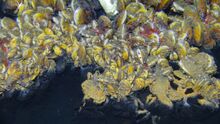
Tiger Mussels near a deep ocean brine pool.
- Main article: Tiger Mussels
Named after their pattern of dark vertical stripes on reddish-orange shells, these mussels were introduced as part of the attempt to restart an oceanic ecosystem. They were the only form of re-introduced fauna that proved hardy enough to survive or out-produce the destruction wrought by the 'black water' algal blooms, that began to plague the Cabina oceans soon after the introduction of the dioxin-resistant engineered black plankton. Tiger Mussels proved great at filtering out the black plankton responsible for black water, but also great at storing the dioxins remaining in the water and their diet, making them deeply poisonous even to otherwise dioxin resistant life. Between their toxicity, hardiness, and ability to spread like a plague, Tiger Mussels soon began to choke out all other forms of benthic life. Currently, the Cabina oceans are dotted with vast fields of poisonous Tiger Mussels. In addition, when colonies find a foothold near populated areas Tiger Mussels are notorious for getting into and clogging up pipes and machinery.
Tiger Mussels can be eaten, but it is strongly discouraged. They are highly poisonous and deadly unless prepared by a master chef able to cut precisely out those parts that can, with the right preparation, be safely eaten. However, because they are so ubiquitous in Cabina saltwater, they are often a very tempting source of food for those of limited means. Cabina hospitals regularly find themselves needing to provide emergency treatment to those suffering from poisoning as a result of eating poorly prepared Tiger Mussel dishes.
Habitation and Settlements[]
Due to the very poor state of census data regarding the population of the Cabina Frontier, no one is quite sure how many people live on Cabina at the moment. However, even the most boldest estimates do not put the figure as far about 15 million. Dependent on which estimate you go by, somewhere between half to a third of the human population lives in one of the planets three major cities: the capital of Lux Gravare, the pilgrim city of Mugenjishi, and the industrial hub of Gadalfo. The rest live dispersed between numerous scattered towns, settlements, temples, monasteries, hermitages, and so on across the Cabina Frontier. In addition to proper settlements, religious sites, whether large temple complexes or tiny shrines, can be found in every environment the planet has to offer: from the tops of lifeless mountains, to the middle of desert wastelands, to the depths of icy caverns.
The Cah-Binn aliens are partly nomadic, and their population is divided into family communities nested inside metal yurts/lodges that bear familial markings shaped by the family elder. The largest and more known of these communities are close to the city of Lux Gravare where they trade with humanity. Each dome is separated individually by at least a 20 kilometer distance.
Wasteland areas surrounding those settlements that are part of biosphere restoration projects, which is the majority, are regularly plagued by deadly Bumbumast ur-swarms. This is an especially lethal problem on the Cabina Frontier, which often lacks the control and contain methods, or immediate medical assistance, that the cities and larger settlements use to prevent or safe victims of Bumbumast attacks.
Capital of Lux Gravare[]

The central district in Lux Gravare.
- Main article: Lux Gravare
Lux Gravare is the capital city of Cabina. It is located in the temperate band that surrounds Cabina's equator, around the Canomere river and the western edge of the Cambalt hills, and just north of the eastern shores of the planet's main continent and the ocean. It is by far the largest city on Cabina, with a population of around two million inhabitants. Most embassies, consulates, and other diplomatic centers are located in this city.
In addition to being the capital city of Cabina, it was also the de facto sector-wide capital city of the Church of Humanity Repentant, as Lux Gravare was home to all the major branches of CHR government. It now houses the administrative and bureaucratic headquarters of SERAPH and its composite entities, which coordinate the Society's efforts across Cabina and throughout the sector.
Lux Gravare is roughly divided into four districts: The Central District, the Southside District, the Riverside District, and the Port District.
Lux Gravare Stadium (The Vardome)[]
- Main article: Lux Gravare Stadium (The Vardome)
The Lux Gravare Stadium is the official stadium of the Cabina Fever Psiball team. The stadium has recently undergone extensive renovation after a friendly match against the team from Shān ended with the stadium in ruins. The renovations were funded by Church of Humanity Repentant member Dr. Lyra Quinn Vardom, as a result of his patronage Cabina Fever fans have nicknamed the renovated stadium ‘The Vardome’.
Lux Gravare Greenbelt[]
The largest area of restored biosphere on the planet is known as the Lux Gravare Greenbelt. It surrounds the capital city of Cabina, and represents both the oldest and the largest of the biosphere restoration projects on the planet. Most of the Greenbelt is covered by fields and crops, but a significant part has been set aside as a recreational wildlife preserve. The Greenbelt is also dotted with small shrines, the burial sites of many early Repentant settlers on Cabina who wanted to be buried in the middle of the nature they worked so hard to restore.
Haakom Homestead[]
Haakon Homestead is technically part of the Cabina Frontier, but being less than a day’s hike from Lux Gravare it could also be considered a suburban neighborhood of the capital site itself. This bustling village consists of several dozen buildings, sitting in the center of a large expanse of farmland. Visitors regularly go back and forth between Haakom and Lux Gravare, many making this trip solely to visit the Tao-Lu ramen shop, which has gotten quite popular amongst some circles in the capital.
City of Mugenjishi[]

A pilgrim at last arrives at the gates of Mugenjishi.
- Main article: Mugenjishi
Mugenjishi is the second largest city on Cabina, after the capital of Lux Gravare but before the industrial center of Gadalfo. It lies roughly 1,000 miles north past the border of Cabina's temperate equatorial region, well into the northern polar ice cap. It was built in a large valley carved out of the ice by the planetary bombardement of the Blood Eagle's fleet. Mugenjishi is dominated by temples and churches, and for many of the more spiritual and esoteric sects of the Repentant faith the city serves as a kind of second capital after that of Lux Gravare.
Only about two-thirds of the city's population is made up off actual permanent residents. Most of which are monks or priests or people otherwise officially affiliated with one of the temples or churches. The remaining third is made up of an ever changing population of pilgrims that come to Mugenjishi for stays lasting from days to years. At peak population, Mugenjishi is inhabited by just over a million people.
Pilgrim's Gate[]
Pilgrim's gate is a small town just on the edge of Cabina's equatorial region. It is the starting point of a pilgrimage that takes pilgrims to Mugenjishi by land. It is an arduous journey, a solid month of travel across hundreds of miles of the Hamasa Glacier (or "Lord Patel Glacier"), and one of Pilgrim's Gate's main features is a hospital equipped with ample medical evacuation shuttles which routinely cross into the polar region to recover over-confident or unlucky pilgrims.
In addition, Pilgrim's Gate also has several people and companies offering shuttles to different starting points, closer to Mugenjishi, up to as much as just hours or days away. However, these have to compete with better funded and equipped services operating directly from the planet's capital of Lux Gravare.
City of Gadalfo "Check-Val-Shivt"[]

Gadalfo at night.
- Main article: Gadalfo
Gadalfo is known as the industrial capital of Cabina. It is the third largest city on the planet and the one most cohabited with the Cah-Binn. The industry of Gadalfo is primarily steel and mineral production harvested from the nearby mountain range known as the Zabrann Mountains. The city stands just south of the temperate band of Cabina and experiences particularly harsh winters. Its location would not normally be considered hospitable enough for human settlement if not for how lucrative the mountain ranges nearby are in terms of wealth of mineral deposits. Gadalfo's population is just shy of one million inhabitants.
Gadalfo was the locale of first contact with the Cah-Binn. This event would later be referred to as the "Gadalfo Incident". The settlers unknowingly built the city adjacent to a particularly significant cultural location. The Cah-Binn name for the canyon that Gadalfo borders is most closely expressed in English phonetics as "checkh-val-shivt Cah-Binn" and roughly translated to "The Bones of the Cah-Binn" or "The Boneyard." It is a mass grave of dead and fossilized alien remains mixed with faunra that has remained somewhat preserved and it is added to by the aliens in ritual fashion whenever a Cah-Binn is brought forward as having died of human causes. However, the canyon is also one of the most mineral-rich locations discovered on Cabina and as such was a major point of contention regarding early diplomatic relations between human settlers and the Cah-Binn who use the presence of the bones of their ancestors as part of a larger debate with mankind and themselves.
Cabina Frontier[]
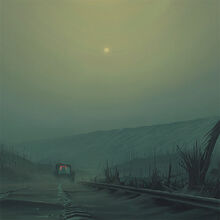
The lonesome Cabina Frontier.
- Main article: Cabina Frontier
Due to a lack of reliable census data, and a seeming lack of interest on the part of the Cabina government to improve said census data, there are no detailed population figures for those who live out in the desolate wastes and oceans of Cabina. However, it is estimated that the population of the Cabina Frontier ranges somewhere from four to nine million inhabitants, spread across thousands of communities ranging from towns of tens of thousands to villages of dozens.
The Cabina Frontier is an important exit point of the Vigil's Railroad.
Continental Towns, Villages, and Homesteads[]
Outside of the three major cities of Lux Gravare, Mugenjishi, and Gadalfo, the human population of Cabina's main continent of Toterra inhabit far-flung towns, villages, and homesteads dedicated to agriculture and the exploitation of natural resources. These outposts provide essential resources for a planet far from the Imperial core, and also provide work and a safe haven for the large refugee populations that Cabina takes in. Settlements closer to Lux Gravare and larger Cah-Binn clan-homes are connected by dedicated roads and rails, while more far-flung settlements largely rely on travelling Cah-Binn caravans for resources they are unable to produce locally. Shuttle services are able to reach anywhere, but are generally too expensive for day-to-day business and trade.
So long as refugees are peaceful and willing to work, the communities of these settlements ask few questions about their origins or backgrounds. This welcoming attitude is partly the result of putting Repentant teachings on charity into practice, but also because many inhabitants of these homesteads are themselves 2nd or 3rd generation descendants of refugees. It is rumored that in addition to runaway serfs and repentant criminals, a significant part of the population of the more remote settlements is currently made up of synth refugees. The Cabina government has assured Crux law enforcement that it has the situation firmly under control and does not require any assistance.
As part of their arrangement with the Cah-Binn, many of these homesteads are also committed to contribute resources and manpower to regrowing Cabina’s devastated biosphere, typically planting Earth-native plants alongside cloned samples of Cabina’s rare surviving native vegetation.
Island Towns, Villages, and Homesteads[]
Roughly a third of the frontier population lives not on the continent, but on archipelago's dispersed throughout Cabina's single great ocean, Maromnis. Island towns, villages, and homesteads are fairly similar to their continental counterparts, except that they are even more isolated and insular. A very small number of Cah-Binn tribes live and travel the oceans, having adapted their exoframes to float and travel the waters by both sail and more advanced means of oceangoing. Generally speaking, the island communities see no visitors except monthly Cabina Cups shuttles, bringing supplies in exchange for the local tea harvest. Only occasionally will such a shuttle bring with it new refugees and/or settlers to increase the local population. These are received with even more wariness, and even less questions, than they'd find in continental frontier communities.
In addition to whatever room there is for crops, most oceanic frontier towns maintain a coral forest in the waters near their settlement. These corals provide little of value for the local community, but the work to maintain or expand them was subsidized by the Church of Humanity, Repentant (mainly through revenue from the Cabina Cups Tea Company). After the collapse of the CHR, the Cabina Cups Tea Company committed to continue sponsoring these reclamation efforts.
Frontier Leagues[]
See also Caffeine Wars Hit Their Boiling Point? by John Davelkolhn
In the power vacuum on Cabina left after the dissolution of The Church of Humanity, Repentant, the frontier towns were approached by various interest groups. In response, they banded together into various alliances to ensure their own common interests were protected. The two largest of these coalitions were the "League of Frontier Towns" and the "Towns of the Frontier League." The League of Frontier Towns associated itself closely with the Ankhayat family and their coffee enterprise, and the Towns of the Frontier League affirmed their association with Cabina Cups Tea.
Major Frontier Settlements[]
Bostra[]
A large frontier settlement largely formed of Tiber and Demnoph emigrants, with a fair amount of pre-established knowledge of coffee-growth, and one of the first broad successes of the Eridanus Ankhayat family in introducing their coffee plant to Cabina. A hub of plantations and drying/processing centers.
Ninurta[]
- Main article: Ninurta
Ninurta is one of Cabina’s larger tea plantations, and, to those in the know, one of the major exit points for those on Vigil's Railroad on the planet.
It is part of a larger biosphere reclamation project. The central town serves as the main reclamation area, slowly expanding over time. Each individual settlement of the plantation is also established as an individual node in the reclamation and expansion of the plantation. As each settlement expands, more and more of the surrounding land is reclaimed, and various nodes are connected to each other and the area surrounding the town.
New arrivals are distributed among the plantation’s many villages, where they are welcomed by the locals and brought into their communities. Individual cells who smuggle refugees onto Cabina manage specific settlements. Given the decentralised nature of the cells, no single person is aware which settlements, if any, are home to refugees except for their own. Cells are often organised on the basis of faith. Each settlement has developed a specific cultural lineage overtime. As new people stay at the settlement, they impart their own customs and teachings to the people of the settlement, but adopt those of the settlement as well.
Varmborg[]
The town of Varmborg is one of the largest towns of the frontier, and the center of a thriving Chrates-Cabinan community numbering in the hundreds of thousands.
Chrates is a cold world, inhabited by a cold people. Ruled by the so-called ‘Frostnax’, estranged relatives of House Fornax, it is a harsh world both in- and outside of its bubble cities. Over the centuries, many thousands of Chrates natives have made the journey to emigrate to the Cabina Frontier which, if no less harsh, is certainly a warmer place to live. The majority settled in the town of Varmborg, the city steadily growing to its current size over several centuries.
Especially to those not otherwise very familiar with frontier towns, Vamborg has become famous for its export of Chrates Chai, one of the many artisanal flavors of Cabina Cups Tea Company. Chrates-Cabinans developed the habit of drinking it iced, as well as hot, to remind them of home. It is a powerful blend of black tea mixed with cardamom and a fine selection of spices. The inclusion of black peppers gives it an extra kick and long-lasting flavor.
Warui Katachi (Little Hong Lu)[]
- See also: Operation Powdered Snow
The city of Warui Katachi sprang into existence due to the large numbers of Hong Luan refugees fleeing the north for a better place to live. The government of Cabina generously accepted the refugees and provided them some land attached to the foundation of the Endoholophusikon.
Utilizing House Triangulum standard-template construction techniques, buildings, arcologies, and habitats were constructed in orbit and delivered to the surface to provide quick and accessible shelter to the refugees. Using their Hong Luan entrepreneur spirit, large businesses and a fairly healthy economy quickly took shape.
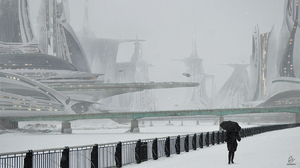
Snow-covered city of Warui Katachi aka Little Hong Lu
Unfortunately, where there is a Hong Luan, there is a criminal not far behind. Naturally opportunistic, the former Red Dogs who took the trip with the refugees have already begun franchising and opening nefarious businesses around Warui Katachi and other parts of the planet. Crime has seen a slight uptick with the influx of refugees but the Governor is adamant that these are within the margin of error of the studies.
The complex shape of the Endokon was considered good luck by many of the locals, who referred to the area as lucky with its presence. Eventually, the idea of the lucky shapes took root and the oriental Hong Luan refugees started to colloquially refer to the city as Warui Katachi, which is said to be the local translation of lucky shapes.
Still a relatively small settlement in comparison to some of the larger cities on Cabina, it has nevertheless become a popular tourist destination for the literal, out-of-this-world ramen noodles.
Notable Planetary Sites and Locations[]
Alyssa's Seclusium[]
A small cave where Alyssa the Humble, a widely revered CHR leader and Great Rethinker, spent the final years of her life. A simple stone hut sits on a bed of wildflowers within a grotto in the hills into the wasteland a short hike from Lux Gravare. A small headstone sits next to it. A nearby spring babbles into a pool, before flowing out of a small hole in the back of the grotto.
Bastion of the Sanctified Soul[]
Close to the Haakom Homestead, and thus less than a day’s travel from Lux Gravare, stands the Bastion of the Sanctified Soul. This is the main temple of the Repentant sect known as the Concord of the Sanctified Souls.
Crash Site of Kriix-aalkrik-voon[]
Deeper into the wastelands surrounding Lux Gravare, the ever-present skeletal trees lean at odd angles, and soon give way to an enormous crater. Inside of the crater lies the bizarre wreckage of what to many would seem to be an enormous spacecraft, dozens of meters in length. Blast-holes are visible in the structure revealing layers of metal, like the layers of an onion.
Though it looks like a spaceship, and it is, it is more than that. It is the remains of the magnificent exoframe of the great Cah-Binn hero Kriix-aalkrik-voon. According to Cah-Binn tales, Kriix-aalkrik-voon was the last of the living Gestalt Exoframes. A great hero, knowing and brave, who guided their people through space to explore other worlds in the time before humanity came to the sector. During the Blood Eagle’s attack on Cabina, the great exoframe ship was shot down, killed, and crashed onto the Cabina soil.
The Cah-Binn still revere Kriix-aalkrik-voon, and humans are discouraged from visiting the crash site except with appropriate reverence.
Endoholophusikon (Endokon)[]
- See also: Operation Powdered Snow
The four-hundred story Endoholophusikon is a marvel of engineering, a miracle of glass and steel relying on nanotech fabrication techniques to produce a building of sweeping, elegant curves that would otherwise be impossible to build using modern construction technology. Even though it currently is a mixed-use building, the Endoholophusikon has been granted extraterritorial status as the embassy of House Triangulum by the government of Cabina.

The Endoholophusikon aka The Endokon
The building houses a truly enormous amount of servers and offices. Some of the floors, however, have been rented out to Hong Lu businessmen, creating a myriad of luxury Hong Lu style spas, restaurants, lounges, and gardens that permeate the Endoholophusikon. Additionally, a massive holo-library has been included that is free to the public and houses nearly every well-known book and treatise in holographic form.
Built upon a vast natural cave complex, the myriad tunnels and caves were converted to black site research facilities, divied between investing Triangulum families. Part of the agreement with the Governor was that the research would be permitted as long as a sizeable percentage of the research is focused on benefitting the planet. So research on the biosphere, atmosphere, hostile environments, VI, defense systems, and more are underway to improve the planet of Cabina.
In addition to the research faculty and administration officials, a sizeable Host of Order of Operations personnel are stationed on the planet, officially for joint Navy exercises. Further accompanying the massive freight of supplies to finish the building were tens of thousands of refugees from Hong Lu, looking for opportunities elsewhere after being offered a way off of Hong Lu. As a result, the immediate area surrounding the Endoholophusikon has taken on a bit of an oriental flair as Hong Lu cuisine and culture began to spread and the city of Warui Katachi was founded.
Notable Orbital Stations[]
The Flying Saucer[]
- Main article: The Flying Saucer
The Flying Saucer is an elegantly furnished space station shaped like a teacup and saucer in low orbit around Cabina, constructed in the early 32nd century. Originally intended to be an exhibition piece for Cabina Cups’ popular new flavour Synthetic Perfection, the station quickly became so popular that the company decided to renovate and reopen it as a permanent orbital teahouse. The Saucer offers a soothing peaceful environment where visitors may relax, drink tea, and converse to the backdrop of the slowly moving panorama of the planet Cabina.
Littleton 9[]
A Cah-Binn ruin in orbit of Cabina, plagued by trigger-happy scavengers meddling with strange alien tech.
Politics[]
Land Administration[]

Flag of Cabina
The majority of land on Cabina is de jure owned by nobles, but de facto the political power on Cabina tends to flow upwards from communities, organizations, and sects making use of this land. The three major cities, and a handful of large frontier towns, have appointed mayors. These are de jure appointed by the major noble landowners to oversee their property, but in practice the nobles appoint these in consultation with the major local communities and religious leaders. In addition, much land on Cabina is leased out by its de jure owners to Repentant sects or charitable organizations for token rents. In the case of frontier communities, whether homesteads or monasteries, these often exist on what are de jure the estates of a noble patrons. De facto, these patrons rarely involves themselves with 'their' communities or, in the case of monasteries, are themselves members of the order.
Governor[]
- Main article: Governor of Cabina
The single most powerful political position on the planet Cabina is that of the planetary governor. The governor of Cabina is de jure appointed by a committee of the major landholding nobles, following a vetting of candidates and final vote. In the past, this meant they were de facto selected by the Concord, the ruling body of the Church of Humanity, Repentant, due to the vast majority of Cabina's landholding nobles being devout members of Repentant sects, and the political power on Cabina tending to flow upwards from Repentant communities and sects. Following the dissolution of the CHR, SERAPH became the major power broker and conglomerate on the planet, and the governor's office works in close contact with this organization and maintains a stakeholding share in it.
The responsibilities of the governor are primarily the coordination of the largely independent communities and governments of Cabina's three major cities (Lux Gravare, Mugenjishi, and Gadalfo), and the thousands of frontier communities. The governor has few de jure political powers. Instead, their power comes largely from everyone on the planet assuming that the governor and their actions have the full backing of the planet's landowners and major societal institutions.
Judiciary and Law Enforcement[]
Law enforcement on Cabina differs greatly between the upper and lower ranks, and between the major cities and the Cabina Frontier.
Upper Ranks[]
The upper ranks of Cabina law enforcement are the Richters and police chiefs and their superiors. These positions are all taken by loyal members of House Crux. For most of Cabina's history, these jobs were filled by House Crux individuals largely attempting to get promoted and transferred out of a backwater assignment. They did their best to maintain the law, even those parts of imperial law not popular with the Repentant faithful, such as synth retirement. Due to hostility from the local population, however, the majority of these Richters and chiefs simply focused on places where they could be properly productive: Namely more mundane criminal issues that did not find the same resistance, such as regular theft, murder, and so on.
Following the Conflict of 3200 and the Cabina Inquiries, nearly 75% of the individuals in these ranks were arrested or reassigned, due to investigations revealing extensive derelection of duty, Repentant sympathies, and even active treachery. Their replacements now attempt to enforce a more unyielding alignment with all aspects of Imperial law, and overall Cabinan law enforcement currently exists in a kind of cold war between the new Crucians in command and the still majority Repentant Lower Ranks (when it comes to issues on which there is disagreement between Repentant and Crucian ethics).
Lower Ranks - Major Cities[]
In the major cities, the lower ranks of Cabina law enforcement are the local beat cops, the lowly detectives, and so on. By and large they are locals, with only the occasional Crux noble thrown in, and thus overwhelmingly made up of Repentant individuals. They are hired by House Crux and provided with some Crux training before being put to work. Usually, they honestly follow their superiors' commands and work hard to keep the people of Cabina safe from crime. However, in cases where official law conflicts with Church sympathies, such as synthetic retirement, these cops have difficult decisions to make. Though some give in to the demands of the law, and the money and prestige House Crux gives to those who keep it, most are more likely to take illegal synthetics to their local Repentant pastor than to their Crux superior.
Lower Ranks - Frontier[]
The Cabina Frontier is largely void of Crux presence, who consider it a backwater in a backwater. The only Crux forces active on the frontier are special ops teams based in the major cities, and they only venture forth into the frontier if it is truly, absolutely necessary.
Regular frontier law enforcement is the domain of sheriffs de facto chosen by the frontier communities themselves, and from amongst their own ranks. Though these sheriffs are nominally and de jure still part of Crux law enforcement, de facto they keep their own law without regard for what anyone outside of the frontier (Crux or otherwise) thinks about it.
Culture[]
General Culture[]
Cabina was for 230 years the homeworld of the Church of Humanity Repentant, and settled primarily by Repentant faithful. Many in the Repentant faith still consider it their spiritual homeworld despite the church's dissolution. Cabina's human population shares the planet with the local indigenous Cah-Binn aliens. The charitable conglomerate SERAPH, among its many initiatives, works diligently to ensure human and Cah-Binn relations remain peaceful and cooperative, following in the CHR's footsteps in this regard.
Cabina is, as of yet, the only planet in the sector where a majority of the population are members of the Repentant faith. In fact, census figures consistently show figures ranging from 80% to 90% of the population being active members of Repentant sects. This means that Repentant beliefs in the innate dignity of all sentient life pervades Cabina culture, and while following the major structures and practices of the empire, Cabina is comparatively free from issues of exploitation or oppression more rampant elsewhere in the sector. Nobles on Cabina are expected, by themselves not least of all, to take the principles of noblesse oblige deeply serious and see themselves as having just as important a duty to take care of their serfs as their serfs have to take care of their nobles.
Of course, this does not mean Cabina is entirely free of exploitation and oppression. But such practices are deeply frowned upon, and it is all too easy for an exploited or oppressed serf to find their way to a friendly Repentant pastor to have their case heard, to receive the attention and aid of various advocacy and watchdog groups, and if need be find themselves spirited away to start a new life in a community on the Cabina Frontier.
Frontier culture is markedly different from that in the major cities. While life in the major cities is defined by living according to Repentant ideals in a largely rich and well-developed environment, life on the frontier puts those ideals to the test against an environment that is harsh and unforgiving. Frontier culture is paradoxically both open and insular. Frontier communities are always open to welcoming refugees or settlers, no questions asked, as long as they prove their willingness to make themselves useful to the community. But those same communities tend to be deeply paranoid of temporary visitors and generally distrust and dislike anyone who isn't part of their tight-knit frontier communities.
Cabinan Language[]
As Cabina was only truly settled by humanity relatively recently, after the Blood Eagle's destruction of the Cah-Binn, its language has had less time to develop than that of other worlds. Many places still see people speak the local languages of their original settlers, or otherwise sees people use imperial common as their native tongue.
The Cabinan language itself is a creole language, comprised from influences of the many different tongues of the Cabinan settlers. Only about half of the Cabinan population speaks it, though all natives will know some trademark Cabinan slang terms, and the majority will have passive understanding of the language.
Cabina Cups Tea[]
- Main article: Cabina Cups Tea
Cabina Cups is a brand of tea that is ubiquitous on Cabina and widely associated with the Repentant Faith sector-wide (positively or negatively, dependent on who you ask). Cabina Cups tea is artisanally grown across Cabina wherever biosphere restoration projects have advanced sufficiently for tea gardens to prosper. Almost every city, village, and temple grows its own local variety of Cabina Cups. The tea comes in hundreds of flavors, most of which are produced only in very small batches. As a result, a box of Cabina Cups will generally have a random assortment of flavors.
The Cabina Cups Tea Company is a non-profit organisation whose profits are invested into Cabina biosphere restoration projects or other charitable projects.
In recent times, Cabina Cups has become a prominent and founding member of SERAPH, a major force in the charitable conglomerate's corporate wing, and a persistent rival to the coffee faction.
Cabina Coffee[]
In the chaos and upheaval following the STO conflict, the Eridanus Ankhayat family acted upon a generations-long plan to bring a second caffeinated beverage to Cabina. Coffea cabina is now increasingly grown on sizable projects across frontier communities, with its processing employing an increasing number of Cabinan residents, and its emergence has made one's position on tea vs. coffee a recurring cultural debate on the planet.
In addition, the current governor is known for his development of the rare Kaffea Arabica, which utilizes Cabina's Varrjac amphibians in its production chain.
Psiball[]
Various populated areas on Cabina maintain their own local Psiball teams, and the best players get selected for the official team representing the Church of Humanity, Repentant: The Cabina Fever.
Papers[]
- Voice of Cabina (most respected and widespread outlet)
- Cabina NEWS! (can veer into more sensational headlines and yellow journalism)
- Repentant Times (news for the religiously devout, often spread by pamphlets from marketing drones)
Notable Cabinan NPCs[]
These characters were explicitly made to serve as NPCs on Cabina, reflecting the culture and setting of the planet. Anyone writing Cabina lore or playing a role-playing game set on Cabina should feel encouraged to reference these characters or have them cameo.
Ms. Minty Repentance[]
- Main article: Lavanya Shimizu
Shinkan Reticulum Shimizu Lavanya -- better known by her title of "Ms. Minty Repentance" -- is the CEO of Cabina Cups Tea Company.
Quantess Eridanus Kirsten Ankhayat[]
- Main article: Kirsten Ankhayat
Kirsten Ankhayat is the head of the Ankhayat family on Cabina. She spearheaded a massive expansion of coffee cultivation on Cabina in the chaos following the dissolution of the CHR.
Governor Grand Chemical Chemex Engineer Triangulum Arabica Kaldi[]
- Main article: Kaldi Arabica
Grand Chemex Chemical Engineer Triangulum Arabica Kaldi, often better known by his moniker "GCCETAK", or as simply "the Grand Chemex," is a member of House Triangulum and the current Governor of Cabina. He is a biochemical engineer and coffee maestro.
He ran on a platform of technocratic meritocracy, and firmly believes that Cabina can be a relevant factor in the sector. He is fairly liberal in his views, but is loyal to the Empire and his House, and his administration's focus is upon increasing the economy through educational initiatives, travel incentives, trade reinforcement, cooperation with the Empire, and refugee acceptance and rehabilitation.
Lord Newt Aquila Macek Columba[]
- Main article: Columba Macek
Columba Macek is a Tribune of House Aquila and served as the head of the imperial garrison on Cabina until both it and they were recalled to Diomikato in 3201. They are the single parent to seven adopted children. They were a candidate in Cabina's Second Governor Election of 3200.
Seeker Pyxis Afolabi Branson[]

Pyxis Afolabi Branson (right) and Esha
- Main article: Branson Afolabi
Branson Afolabi is a member of House Pyxis and the head of the Afolabi family on Cabina. He is a notable sponsor of the Maajid Memorial Foundation for the Education of Humanity. He was a candidate in Cabina's Second Governor Election of 3200, but leaked news of his more eccentric tendencies placed him largely out of the running.
Esha[]
- Main article: Esha Surya-Qusay
Formerly known as Fakri Vela Surya-Qusay Esha, Esha is now the head serf of the Afolabi family in an arrangement which saw the Afolabi family become a de facto front for the clandestine continuation of the Surya-Qusay family following the Exigo of House Vela. (In return for which the Afolabi family received immense wealth and influence for its various Repentant and alien-related passion projects.)
Serving directly under Branson Afolabi, Esha spents most of her time divided between managing the former Surya-Qusay (now Afolabi) estates and trying to keep Branson or his family members out of the trouble or embarrassment they seem to insist on getting themselves into.
Fumu Guan Reticulum Fei Hong[]
- Main article: Hong Fei
Fei Hong is a member of House Reticulum and recent immigrant to Cabina. She is an ardent supporter of the High Church and a renowned scholar on Arhat Zetian She was candidate in Cabina's Second Governor Election of 3200, and after her loss began to make a name for herself preaching in the ruins of the CHR Hall of the Concord to both curious and hostile crowds, and lobbying heavily for SERAPH to continue its outreach to the High Church regarding joint charitable initiatives.
Count Eridanus Ankhayat Emil[]
- Main article: Emil Ankhayat
Emil Ankhayat is the son and heir of Quantess Eridanus Ankhayat Kirsten, and a lead negotiator in the Ankhayat family's coffee expansion on Cabina. He was a candidate in Cabina's Second Governor Election of 3200, but his candidacy floundered following a romantic scandal and association with unorthodox writings.
John Davelkolhn[]
- Main article: John Davelkolhn
John Davelkolhn is a reporter for PRISM Network News, reporting mainly for their Citrine Yellow channel (culture/religion/art).
Truecaller Canary Samuel Samson[]
- Main article: Samuel Samson
Samuel Samson is a member of the Repentant sect The Sky is a Lie. He is a familiar sight on the streets of Lux Gravare where he preaches his message. He ran as an unvetted candidate in the Cabina's Second Governor Election of 3200.
Roger Spittoon[]
- Main article: Roger Spittoon
Roger Spittoon is a street preacher/performer residing in Gadalfo, Cabina. He is the founder of the sect Mudders of the Earth. He ran as an unvetted candidate in the Cabina's Second Governor Election of 3200.
Xun Hui Man[]
- Main article: Xun Hui Man
Xun Hui Man (勋慧文) is a Cabinan notable publicly known as a self-made freeman, philanthropist, and a pillar of the local Hong Luan community in the planetary capital of Lux Gravare and the Benilli system at large. Not so publicly, he is a ruthless crime boss, formerly aligned with the 14 Red Dogs Triad, and with that organization’s official dissolution he is now attempting to play both House Triangulum and SERAPH as he maintains and expands his criminal operations for no one’s benefit except his own.
Inspirational Artwork[]
Below are collections of artwork gathered from the internet that can be used as an inspiration for imagining the people and places of Cabina.
Cabina Geography and Architecture[]
Cabina Fashion[]
Planet Tags[]
Friendly Foe[]
Some hostile alien race or malevolent cabal has a branch or sect on this world that is actually quite friendly toward outsiders. For whatever internal reason, they are willing to negotiate and deal honestly with strangers, and appear to lack the worst impulses of their fellows.
Enemies:[]
- Driven hater of all their kind
- Internal malcontent bent on creature conflict
- Secret master who seeks to lure trust
Friends:[]
- Well-meaning bug-eyed monster
- Principled eugenics cultist
- Suspicious investigator
Complications:[]
- The group actually is as harmless an benevolent as they seem
- The group offers a vital service at the cost of moral compromise
- The group still feels bonds of affiliation with their hostile brethren
Things:[]
- Forbidden xenotech
- Eugenic biotech template
- Evidence to convince others of their kind they are right
Places:[]
- Repurposed maltech laboratory
- Alien conclave building
- Widely-feared starship interior
Theocracy[]
The planet is ruled by the priesthood of the predominant religion or ideology. The rest of the locals may or may not be terribly pious, but the clergy have the necessary military strength, popular support or control of resources to maintain their rule. Alternative faiths or incompatible ideologies are likely to be both illegal and socially unacceptable.
Enemies:[]
- Decadent priest-ruler
- Zealous inquisitor
- Relentless proselytizer
- True believer
Friends:[]
- Heretic
- Offworld theologian
- Atheistic merchant
- Desperate commoner
Complications:[]
- The theocracy actually works well
- The theocracy is decadent and hated by the common folk
- The theocracy is divided into mutually hostile sects
- The theocracy is led by aliens
Things:[]
- Precious holy text
- Martyr's bones
- Secret church records
- Ancient church treasures
Places:[]
- Glorious temple
- Austere monastery
- Academy for ideological indoctrination
- Decadent pleasure-cathedral
Xenophiles[]
The natives of this world are fast friends with a particular alien race. The aliens may have saved the planet at some point in the past, or awed the locals with superior tech or impressive cultural qualities. The aliens might even be the ruling class on the planet.
Enemies:[]
- Offworld xenophobe
- Suspicious alien leader
- Xenocultural imperialist
Friends:[]
- Benevolent alien
- Native malcontent
- Gone-native offworlder
Complications:[]
- The enthusiasm is due to alien psionics or tech
- The enthusiasm is based on a lie
- The aliens strongly dislike their “groupies”
- The aliens feel obliged to rule humanity for its own good
- Humans badly misunderstand the aliens
Things:[]
- Hybrid alien-human tech
- Exotic alien crafts
- Sophisticated xenolinguistic and xenocultural research data
Places:[]
- Alien district
- Alien-influenced human home
- Cultural festival celebrating alien artist
Gas Giant Mine[]
Johnstown Mine Project[]
For main article, see Johnstown Mine Project on the Benilli system page.
Occupation: Miserable gas-miner slaves or serfs
Situation: They need vital supplies
Orbital Ruin[]
Littleton 9[]
Occupation: Trigger-happy scavengers
Situation: Meddling with strange tech
Society for Ethical Reform through Aid, Protection, and Humanitarianism (SERAPH) | |
|---|---|
| Planets | |
| Cities & Places | |
| Charitable Entities | |
| Corporate Entities | |
| Diplomacy & Politics | |
| History & Culture | |
| Sponsor Organizations | |
| Underground | |
| Faction Turn | |
